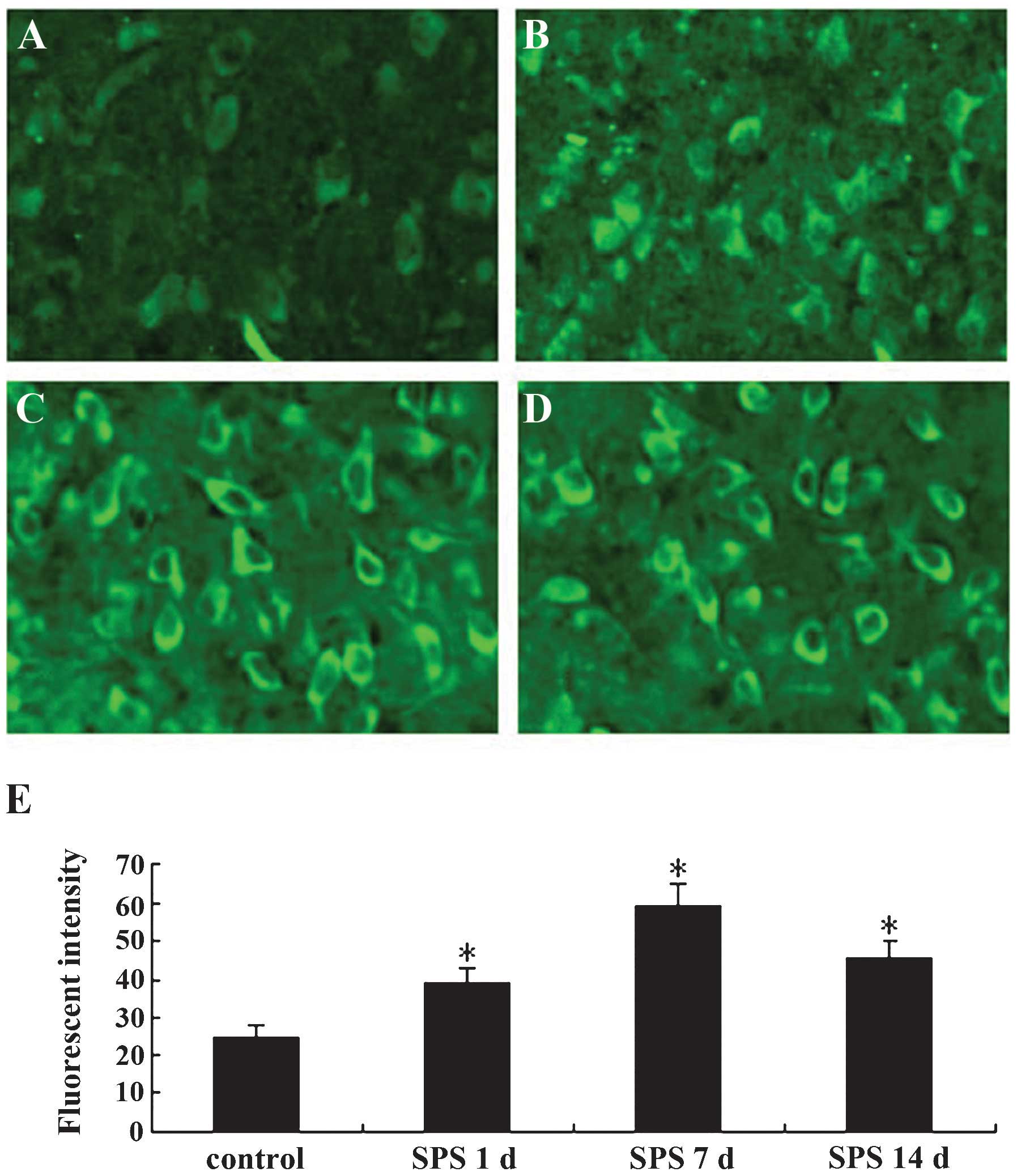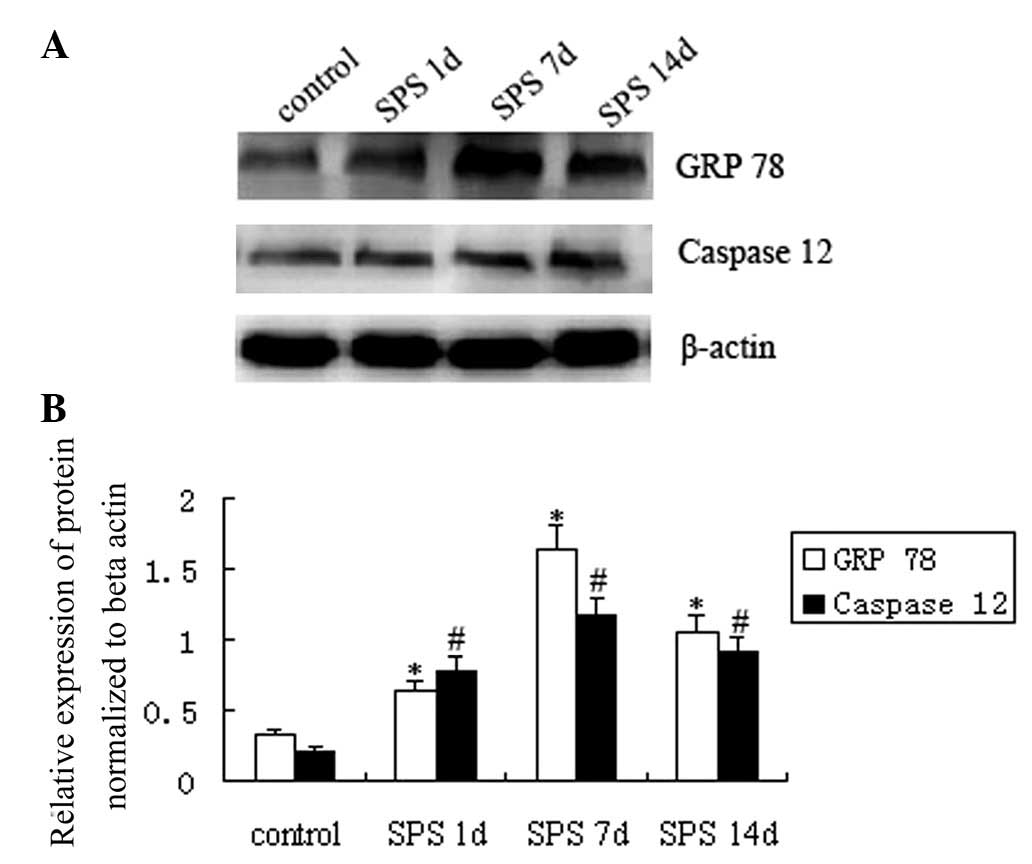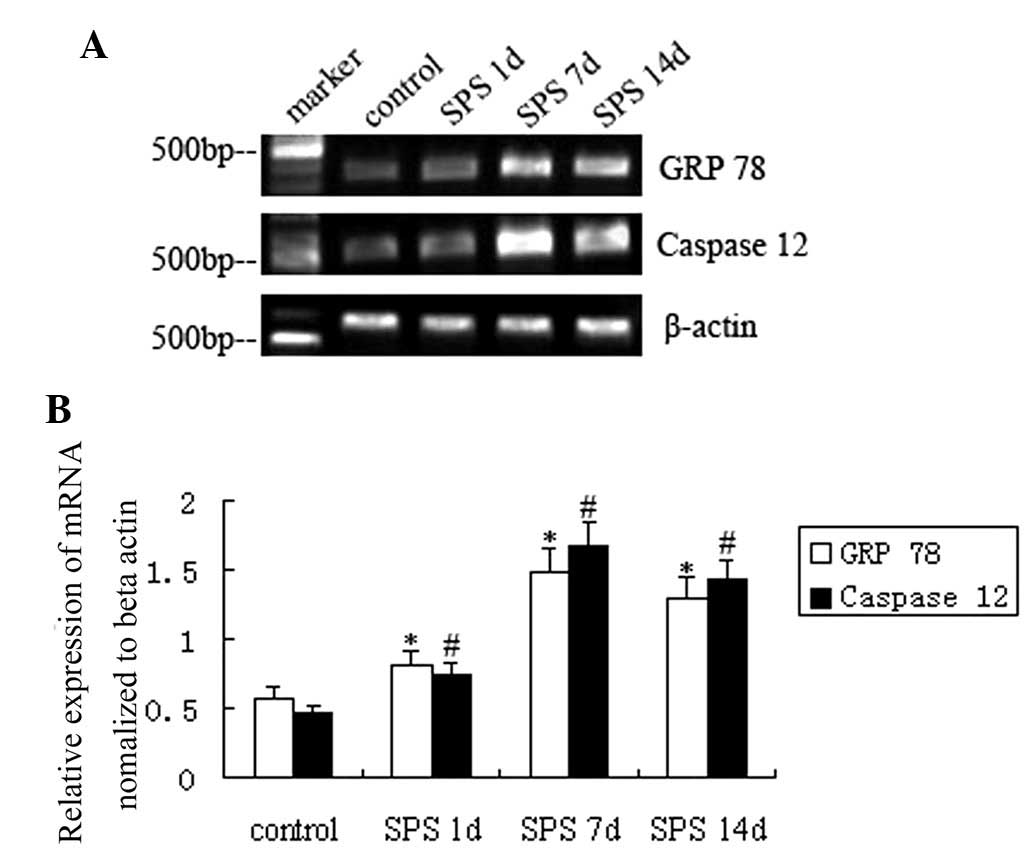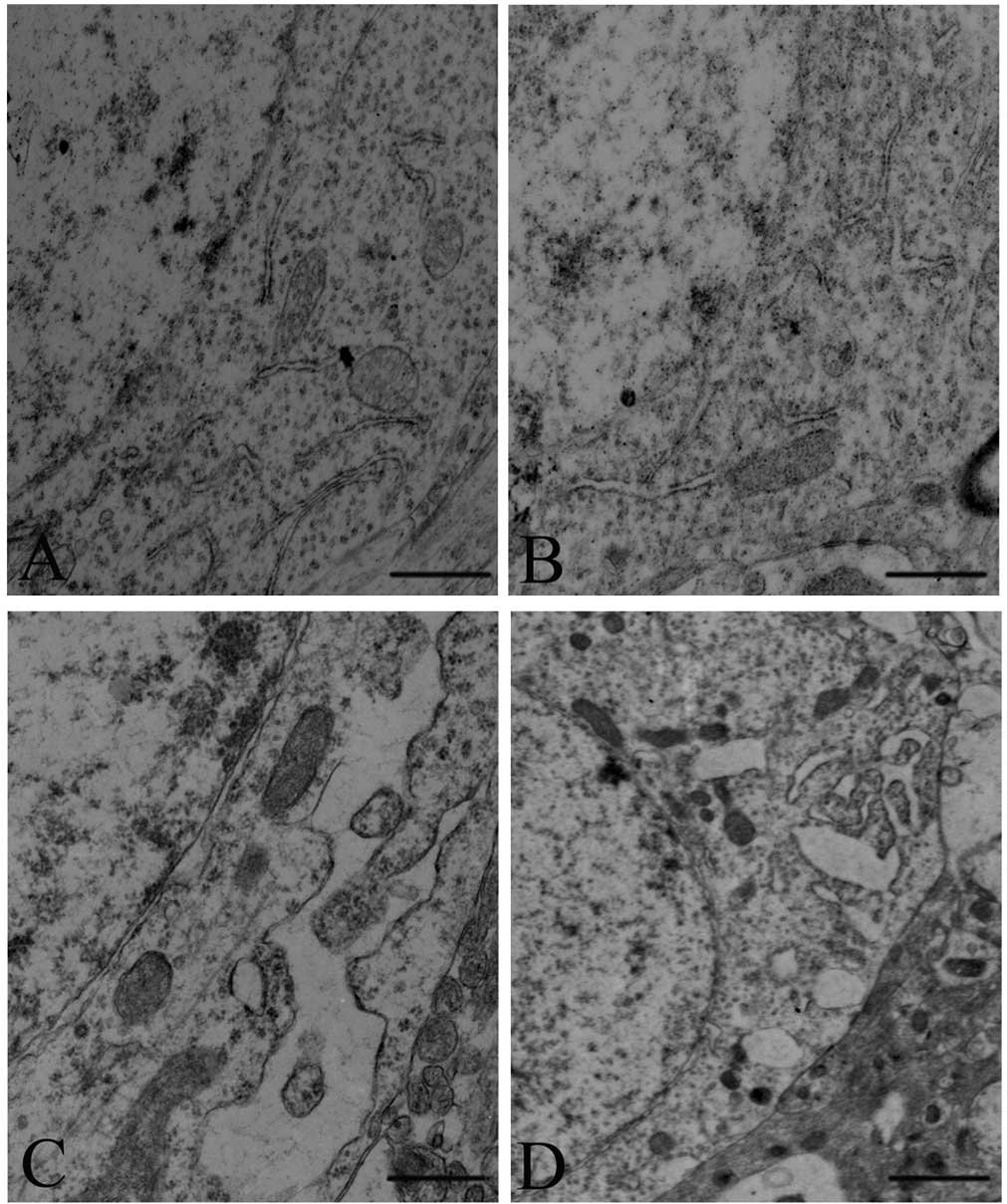Single prolonged stress induces dysfunction of endoplasmic reticulum in a rat model of post-traumatic stress disorder
- Authors:
- Published online on: April 2, 2015 https://doi.org/10.3892/mmr.2015.3590
- Pages: 2015-2020
Abstract
Introduction
Post-traumatic stress disorder (PTSD) is an anxiety disorder that develops after exposure to a life-threatening traumatic experience. It is characterized by symptoms that often endure for years, including continuous re-experience of the traumatic event, avoidance of stimuli associated with the trauma, numbing of general responsiveness and increased arousal (1).
The endoplasmic reticulum (ER), a multifunctional signaling organelle, has a vital role in a variety of cellular functions, including post-translation modifications, synthesis and folding of membrane and secretory proteins, calcium sequestration for intracellular calcium homeostasis and apoptosis (2–4). Physiological and pathological stimuli that disrupt ER homeostasis can induce ER dysfunction or ER stress, including the accumulation of unfolded or misfolded proteins, oxidative stress, perturbation of calcium homeostasis and viral infection (5).
The 78-kDa glucose-regulated protein (GRP78), identical to the immunoglobulin heavy chain-binding protein (BiP), belongs to the heat shock protein 70 group and is located in the ER lumen. GRP78 was one of the best characterized ER chaperone proteins and its synthesis can be stimulated by a variety of environmental and physiological stress conditions that perturb ER function and homeostasis (6). GRP78 is currently regarded as the master regulator of the unfolding protein response (UPR) pathway (7), which may participate in mediate neuronal cell death after traumatic brain injury (8).
Caspase-12 is localized to the ER and has been shown to be activated by ER stress, including disruption of ER calcium homeostasis and accumulation of excess proteins in the ER (9,10). Caspase-12 is also the key molecule in ER-associated apoptosis and activated caspase-12 can activate downstream apoptosis executioners, such as caspase-3, leading to apoptosis (11).
Amygdala, one of the key regions in the limbic system of the brain, has been recognized as a crucial brain structure involved in fear, rage and emotional memory (12,13). Amygdala is usually divided into three distinct nuclear subgroups: Central nucleus, corticomedial nucleus and basolateral nucleus (14). Among these different nuclear sub-groups, the basolateral nucleus is the largest nucleus of the amygdaloid complex (15), which is a putative site of emotional memory and regulation of anxiety (16,17). Thus, the present study focused on changes of the basolateral nucleus.
Single prolonged stress (SPS) (18) was shown to induce enhanced inhibition of the hypothalamo-pituitary-adrenal (HPA) axis, which is a putative neuroendocrinological hallmark of PTSD (19–21). Subsequently, SPS paradigms were extensively developed and employed in the investigation of PTSD (22,23). The present study investigated the effects of SPS on the function of the ER by detecting GRP78 and caspase 12 in the amygdala of rats, and aimed to examine whether there was a link between an established rat model of PTSD and the ER of amygdala neurons. The findings revealed part of the pathogenesis and provided novel insight into the mechanism of how amygdala may participate in PTSD.
Materials and methods
Experimental animals
Eighty male Wistar rats, aged 7 or 8 weeks at the start of the study, weighing approximately 150–160 g, were supplied by the Animal Experimental Center, China Medical University. Rats were individually housed in an air-conditioned room (22±1°C and 55±5% humidity) on a 12-h light/dark schedule with free access to food and water.
The rats were raised in the laboratory for at least 7 days prior to conducting the experiment. Experiments were performed in accordance with the National Institute of Health Guide for the care and use of laboratory animals, and approved by the Welfare & Ethics Committee of Experimental Animals (China Medical University, Shenyang, China). All efforts were made to reduce the number of animals used and to minimize animal suffering during the experiment.
Model establishment and grouping
Animals were divided randomly into four groups: 1) Control group; 2) SPS 1 d (1 day) group; 3) SPS 7 d (7 day) group; and 4) SPS 14 d (14-day) group. Control animals remained in their home cages with no handling for 7 or 14 days and were sacrificed at the same time as the SPS groups. SPS 1-, 7-and 14-day groups refer to the time after exposure to SPS. SPS rats underwent the SPS procedure on the first day. The SPS protocol was based on a combined plural stress paradigm (24,25): Immobilization (compression with plastic bags) for 2 h, forced swimming in a clear acrylic cylinder for 20 min (24±1°C), rest for 15 min, followed by ether anesthesia (until consciousness was lost).
Perfusion-based sections
Rats of the normal control and SPS groups were prepared via left ventricle perfusion and fixation (26) with 200 ml of pre-cooled heparinized 0.9% saline, followed by 300 ml of 4% paraformaldehyde in 0.01 M phosphate-buffered saline (PBS) (pH 7.2–7.4). Brains were rapidly removed and post-fixed in the same fixative for 4–6 h at 4°C, and were immersed in a 20% sucrose solution in 0.01 M phosphate buffer (PB; pH 7.4) at 4°C thereafter. Samples were snap-frozen in liquid nitrogen and 12-µm coronal sections were prepared for morphological studies.
Immunofluorescence analysis of GRP78
The sections of the normal control and SPS groups were treated with 5% bovine serum albumin (BSA; Roche Co., Shanghai, China) and 0.3% Triton X-100 (Sigma-Aldrich, St. Louis, MO, USA) in PBS for 30 min to block non-specific staining at room temperature (RT). Endogenous peroxidase was inactivated with 3% H2O2 in double distilled H2O for 5 min at room temperature. The sections were then incubated with GRP78 mouse monoclonal antibody (A-10) (1:200 dilution; cat. no. sc-376768; Santa Cruz Biotechnology, Inc., Dallas, TX, USA) in 2% BSA-PBS overnight at 4°C. After being washed with PBS three times, the sections were incubated with fluorescein isothiocyanate goat anti-mouse monoclonal immunoglobulin G (IgG) (1:50 dilution; cat. no. BA1101; Boster Biological Technology, Wuhan, China) for 2 h at room temperature. To assess non-specific staining, several sections in every experiment were incubated in buffer without primary antibody. Slices were then mounted with glycerin and observed by fluorescence microscopy (BX61+DP71; Olympus Corp., Tokyo, Japan).
Fifteen slides were randomly selected from each group. In each slide, five visual fields in the basolateral amygdala were randomly selected (magnification, x400). The optical density (OD) of GRP78-immunopositive cells in each field was recorded to evaluate the average OD.
Western blot analysis of GRP 78 and caspase 12
Rats of the normal control and SPS groups were rapidly decapitated following inhalation anesthesia with ether, and the brains were removed and immediately placed in a dish standing on crushed ice. The basolateral amygdala was then dissected out according to the atlas of rats (27) using a stereomicroscope (SZX12; Olympus Corp.) and washed twice with 0.01 M PBS (pH 7.2–7.4) at 4°C. Then the samples were homogenized with a sample buffer containing 200 mM tris-buffered saline (TBS), pH 7.5, 4% SDS, 20% glycerol, 10% 2-mercaptoethanol and were denatured by boiling for 3 min. The protein fraction (50 µg/lane) prepared from each sample was separated by 12% (w/v) gradient SDS-PAGE and electroblotted to a polyvinylidene difluoride (PVDF) membrane (Millipore, Bedford, MA, USA) from the gel using a semi-dry blotting apparatus (Bio-Rad Laboratories, Inc., Hercules, CA, USA).
The membrane was blocked with 5% skimmed milk powder and 0.05% Tween-20 (KeyGen Biotech. Co., Ltd., Nanjing, China) in TBS at room temperature for 2 h and incubated with GRP78 mouse monoclonal antibody (A-10) (1:200 dilution; cat. no. sc-376768; Santa Cruz Biotechnology, Inc.,) or caspase 12 rabbit polyclonal antibody (1611) (1:500 dilution; cat. no. sc-21747; Santa Cruz Biotechnology, Inc.) overnight at 4°C.
Blots were washed three times with TBST and then incubated with horseradish peroxidase-conjugated goat anti-mouse (1:400; cat. no. sc-2073) or goat anti-rabbit (1:400; cat. no. sc-2040) IgG secondary antibodies for 2 h at room temperature and washed with TBST. After the incubation, the PVDF membrane was washed three times with TBST prior to visualization by enhanced chemiluminescence (ECL; KeyGen Biotech. Co., Ltd.). To confirm equal protein loading, the same blots were re-incubated with antibodies specific for β-actin (1:100 dilution; mouse monoclonal; cat. no. BM0627; Boster Biological Technology), which were detected using ECL. The OD was analyzed using the Gel Image Analysis System (Tanon 2500R; Tanon, Shanghai China). The relative expression levels of GRP78 and caspase 12 were determined by calculating the OD ratio of GRP78/β-actin and caspase 12/β-actin.
Semiquantitative reverse transcription-polymerase chain reaction (RT-PCR) for detection of GRP78 and caspase 12
Total mRNA of each group was extracted from the basolateral amygdala according to the instructions of the TRIzol kit (Invitrogen Life Technologies, Carlsbad, CA, USA) and 1 µg of total RNA was reverse transcribed into cDNA. cDNA was amplified using an RNA PCR kit (AM Ver. 3.0; Takara Bio, Inc., Otsu, Japan). The primers were designed and synthesized by Shenggong Biotech Company (Shanghai, China) according to the serial number from GenBank and are shown in Table I. The reaction was started at 94°C for 2 min, amplification comprised 30 cycles of 30 sec at 94°C, 30 sec at 56°C, 40 sec at 72°C (for GRP78) or 27 cycles of 30 sec at 94°C, 30 sec at 50°C, 45 sec at 72°C (for caspase-12) and ended with 5 min extension at 72°C, using XP Thermal Cycler (Hangzhou Bioer Technology Co., Ltd., Hangzhou, China). β-actin mRNA used as an internal control and was co-amplified with GRP78- or caspase 12- mRNA. The products were separated by electrophoresis on a 1.2% agarose gel, and the density of each band was analyzed using the Gel Image Analysis System (Tanon 2500R; Tanon). The levels of GRP78- and caspase 12-mRNA were determined by calculating the density ratio of GRP78 mRNA/β-actin mRNA or caspase 12 mRNA/β-actin mRNA.
Assessment of morphological changes of the ER using transmission electron microscopy (TEM)
Rats of each group were perfused with pre-cold heparinized 0.9% saline, followed by 0.01 M PBS (pH 7.2–7.4) containing 4% paraformaldehyde and 2.5% glutaraldehyde. The brain was removed and dissected on ice, followed by 4–6 h of post-fixation in the same fixative at 4°C. The basolateral amygdala was dissected by using a stereomicroscope and cut into blocks of ~1 mm3. The blocks were post-fixed in 1% osmium tetroxide for 2 h at 4°C. They were rinsed in 0.01 M PBS (pH 7.4) several times, dehydrated in a graded series (20–100%) of ethanol and then in acetone, infused with Epon 812, and finally polymerized in pure Epon 812 (Serva, New York, NY, USA) at 65°C for 72 h. The basolateral amygdala was localized on semi-thin sections. Ultra-thin sections were cut on an ultramicrotome, collected on copper grids, and stained with 4% uranyl acetate and lead citrate. A minimum of 5 sections comprising ~250 cells from each basolateral amygdala were studied with transmission electron microscopy (TEM-1200EX; 80KV; Jeol Ltd., Tokyo, Japan).
Statistical analysis
All values were expressed as the mean ± standard error. Data among groups were analyzed by one-way analysis of variance using SPSS 13.0 software (SPSS, Inc. Chicago, IL, USA). P<0.05 was considered to indicate a statistically significant difference between values.
Results
SPS increases GRP78 and caspase 12 levels in the basolateral amygdale
The immunofluorescence staining results are shown in Fig. 1. The GRP78 protein was located in the cytoplasm (Fig. 1A–D). In the normal control group, the fluorescent intensity of GRP78-positive cells was low, while that in SPS rats was significantly higher and was highest at 7 days after exposure to SPS (Fig. 1E) (P<0.01).
In the western blots, immunoreactive signals for GRP78, caspase 12 and β-actin appeared at 78 kDa, 50 kDa and 42 kDa, respectively (data not shown), and the mean value of band densities of the control group was set as 100%. Data were expressed as normalized optical density. GRP78 and caspase 12 protein levels in the basolateral amygdala region of the different groups are presented in Fig. 2A. The results showed that SPS exposure resulted in a significant change of GRP78 and caspase 12. GRP78 expression was upregulated 1 day after SPS stimulation as compared with that in the control group, was highest in the SPS 7 d group and was decreased thereafter in the SPS 14 d group, while still being higher than that in the SPS 1 d group (P<0.05). Similarly, caspase 12 protein expression in the SPS model groups also showed a significant upregulation in comparison with control rats, was highest in the SPS 7 d and then declined in the SPS 14 d group (Fig. 2B) (P<0.05).
For semiquantitative PCR, levels of GRP 78 and caspase-12 mRNA were normalized to β-actin mRNA levels. In analogy with the protein levels, mRNA levels of GRP 78 and caspase-12 gradually increased after SPS stimulation compared with those in the control group and were highest at SPS 7 d (P<0.01) (Fig. 3).
SPS causes morphological changes of the ER of amygdala neurons
As shown in Fig. 4A, the intracellular ER of amygdala neurons exhibited a normal structure in the control rats (Fig. 4A). Mild distension of the ER was observed in the SPS 1 d group (Fig. 4B). A tumescent ER, ER vacuolization and degranulation of ER were observed in the SPS 7 d group (Fig. 4C) (P<0.05). Furthermore, as shown in Fig. 4D, the ER of amygdala neurons also exhibited an abnormal structure in the SPS 14 d group.
Discussion
PTSD is thought to involve a disfunction in response to fear-associated stimuli. Four major types of characteristic symptoms of PTSD are re-experiencing, avoidance, numbing and hyperarousal (1). The specific role of amygdala in the processing of threat-associated stimuli, in particular anger and fear, has been well documented based on investigations on animals and humans (28–30). Numerous lines of evidence have implicated the basolateral amygdala (BLA) as a substrate for stress-associated modulation of memory (31). Therefore, the present study focused on observing SPS-induced changes in the basolateral nucleus.
A previous study has demonstrated that ER stress is closely associated with several diseases, including neuronal cell injury (32), Alzheimer’s disease (33) and Parkinson’s disease (34). In the present study, changes in the levels of ER stress protein GRP78 and ER-resident caspase-12 in the amygdala of rats were detected in order to identify whether ER stress is involved in PTSD. GRP78, the master regulator of the UPR pathway and a molecular chaperone in the ER that provides cytoprotection in response to cellular stresses, was significantly upregulated in the rats after exposure to SPS stimuli, which may have resulted in dysfunction of the ER. Caspase 12 was also significantly upregulated after SPS stimulation. The results of the morphological evaluation showed that tumescent ER, ER vacuolization and degranulation of the ER were present in the SPS groups. In conclusion, the results indicated that GRP78 and caspase 12 were significantly upregulated and morphological changes in the amygdala of rats were present after exposure to SPS. The possible reason for this is that SPS stimuli induced the activation of the UPR pathway, and the accumulation of unfolded or misfolded proteins led to ER dysfunction of amygdala neurons, which may play an important role in the pathobiological basis for the abnormality of affect and behavior induced by PTSD.
One limitation of the present study is that it did not examine whether apoptosis was induced via the ER pathway in the amygdala, although a previous study by our group has demonstrated that SPS induced more apoptotic cells and increased the apoptotic rate in the amygdala of rats after exposure to SPS compared with that in the normal control group (35). Further study will examine whether apoptosis activated by ER stress participates in mechanisms of PTSD. The results of the present study revealed increases in the levels of ER stress protein GRP78 and ER-resident caspase-12; however, their pathophysiological roles in PTSD remain elusive.
At present, the pathogenesis of PTSD is not yet entirely clear. PTSD may cause a series of biochemical abnormalities and dysfunction of the amygdala, which leads to dysfunction of the brain (36). The present study has shed light on the cellular mechanisms of ER stress in the amygdala and their participation in the pathogenesis of PTSD, which may lead to the development of novel treatments for PTSD. Further investigation into the molecular mechanisms of how the ER regulates neuronal function and the exact cellular pathway should also be elucidated. Thus, the pathogenesis of PTSD requires further investigation.
Acknowledgments
The present study was supported by a grant from the National Natural Science Foundation of China (no. 31200772) and the Doctoral Program Research Foundation of Higher Education of China (no. 20132104110021). The authors would like to thank the anonymous reviewers for their valuable comments on how to improve the quality of the paper.
References
|
American Psychiatric Association: Diagnostic and Statistical Manual of Mental Disorders. 4th ed. (DSM-IV). American Psychiatric Press; Washington DC: 1994 | |
|
Corbett EF and Michalak M: Calcium, a signaling molecule in the endoplasmic reticulum. Trends Biochem Sci. 25:307–311. 2000. View Article : Google Scholar : PubMed/NCBI | |
|
Nakamura K, Bossy-Wetzel E, Burns K, et al: Changes in endoplasmic reticulum luminal environment affect cell sensitivity to apoptosis. J Cell Biol. 150:731–740. 2000. View Article : Google Scholar : PubMed/NCBI | |
|
Su HL, Liao CL and Lin YL: Japanese encephalitis virus infection initiates endoplasmic reticulum stress and an unfolded protein response. J Virol. 76:4162–4171. 2002. View Article : Google Scholar : PubMed/NCBI | |
|
Rao RV and Bredesen DE: Misfolded proteins, endoplasmic reticulum stress and neurodegeneration. Curr Opin Cell Biol. 16:653–662. 2004. View Article : Google Scholar : PubMed/NCBI | |
|
Lee AS: The ER chaperone and signaling regulator GRP78/Bip as a monitor of endoplasmic reticulum stress. Methods. 35:373–381. 2005. View Article : Google Scholar : PubMed/NCBI | |
|
Radley JJ, Arias CM and Sawchenko PE: Regional differentiation of the medial prefrontal cortex in regulating adaptive responses to acute emotional stress. J Neurosci. 26:12967–12976. 2006. View Article : Google Scholar : PubMed/NCBI | |
|
Martinez JA, Zhang Z, Svetlov SZ, et al: Calpain and caspase processing of caspase-12 contribute to the ER stress-induced cell death pathway in differentiated PC12 cells. Apoptosis. 15:1480–1493. 2010. View Article : Google Scholar : PubMed/NCBI | |
|
Momoi T: Caspases involved in ER stress-mediated cell death. J Chem Neuroanat. 28:101–105. 2004. View Article : Google Scholar : PubMed/NCBI | |
|
Nakagawa T, Zhu H, Morishima N, et al: Caspase-12 mediates endoplasmic-reticulum-specific apoptosis and cytotoxicity by amyloid-β. Nature. 403:98–103. 2000. View Article : Google Scholar : PubMed/NCBI | |
|
Liu LQ, Fan ZQ, Tang YF and Ke ZJ: The Resveratrol attenuates ethanol-induced hepatocyte apoptosis via inhibiting ER-related caspase-12 activation and PDE activity in vitro. Alcohol Clin Exp Res. 38:683–693. 2014. View Article : Google Scholar | |
|
McGaugh JL and Cahill L: Interaction of neuromodulatory systems in modulating memory storage. Behav Brain Res. 83:31–38. 1997. View Article : Google Scholar : PubMed/NCBI | |
|
LeDoux JE: Emotion: clues from the brain. Annua Rev Psychol. 46:209–235. 1995. View Article : Google Scholar | |
|
Harding AJ, Stimson E, Henderson JM, et al: Clinical correlates of selective pathology in the amygdala of patients with Parkinson’s disease. Brain. 125:2431–2445. 2002. View Article : Google Scholar : PubMed/NCBI | |
|
Sims KS and Williams RS: The human amygdaloid complex: a cytologic and histochemical atlas using Nissl, myelin, acetyl-cholinesterase and nicotinamide adenine dinucleotide phosphate diaphorase staining. Neuroscience. 36:449–472. 1990. View Article : Google Scholar | |
|
Davis M: The role of the amygdala in emotional learning. Int Rev Neurobiol. 36:225–266. 1994.PubMed/NCBI | |
|
McGaugh JL, Mclntyre CK and Power AE: Amygdala modulation of memory consolidation: interaction with other brain systems. Neurobiol Learn Mem. 78:539–552. 2002. View Article : Google Scholar | |
|
Liberzon I, Krstov M and Young EA: Stress-restress: effects on ACTH and fast feedback. Psychoneuroendocrinology. 22:443–453. 1997. View Article : Google Scholar : PubMed/NCBI | |
|
Stein MB, Yehuda R, Koverola C, et al: Enhanced dexamethasone suppression of plasma cortisol in adult women traumatized by childhood sexual abuse. Biol Psychiatry. 42:680–686. 1997. View Article : Google Scholar : PubMed/NCBI | |
|
Yehuda R: Biology of posttraumatic stress disorder. J Clin Psychiatry. 62:41–46. 2001.PubMed/NCBI | |
|
Yehuda R: Neuroendocrine aspects of PTSD. Handb Exp Pharmacol. 169:371–403. 2005. | |
|
Khan S and Liberzon I: Topiramate attenuated exaggerated acoustic startle in an animal model of PTSD. Psychopharmacology (Berl). 172:225–229. 2004. View Article : Google Scholar | |
|
Iwamoto Y, Morinobu S, Takahashi T, et al: Single prolonged stress increases contextual freezing and the expression of glycine transporter 1 and vesicle-associated membrane protein 2 mRNA in the hippocampus of rats. Prog Neuropsychopharmacol Biol Psychiatry. 31:642–651. 2007. View Article : Google Scholar : PubMed/NCBI | |
|
Takahashi T, Morinobu S, Iwamoto Y, et al: Effect of paroxetine on enhanced contextual fear induced by single prolonged stress in rats. Psychopharmacology (Berl). 189:165–173. 2006. View Article : Google Scholar | |
|
Kohda K, Harada K, Kato K, et al: Glucocorticoid receptor activation is involved in producing abnormal phenotypes of single-prolonged stress rats: a putative post-traumatic stress disorder model. Neuroscience. 148:22–33. 2007. View Article : Google Scholar : PubMed/NCBI | |
|
Liu HY: Technical operations and its common problems of perfusion fixation in mice. Qiqihaer Yixueyuan Xuebao. 27:13412006. | |
|
Paxinos G and Watson C: The Rat Brain in Stereotaxic Coordinates. 4th edition. Academic Press; 1998 | |
|
Derntl B, Windischberger C, Robinson S, et al: Amygdala activity to fear and anger in healthy young males is associated with testosterone. Psychoneuroendocrinology. 34:687–693. 2009. View Article : Google Scholar : PubMed/NCBI | |
|
McGauqh JL: The amygdala modulates the consolidation of memories of emotionally arousing experience. Annu Rev Neurosci. 27:1–28. 2004. View Article : Google Scholar | |
|
Cahill L and McGaugh JL: Mechanisms of emotional arousal and lasting declarative memory. Trends Neurosci. 21:294–299. 1998. View Article : Google Scholar : PubMed/NCBI | |
|
Chavez CM, McGaugh JL and Weinberger NM: The basolateral amygdala modulates specific sensory memory representations in the cerebral cortex. Neurobiol Learnand Mem. 91:382–392. 2009. View Article : Google Scholar | |
|
Paschen W and Frandsen A: Endoplasmic reticulum dysfunction-a common denominator for cell injury in acute and degenerative diseases of the brain. J Neurochem. 79:719–725. 2001. View Article : Google Scholar : PubMed/NCBI | |
|
Katayama T, Imaizumi K, Sato N, et al: Presenilin-lmutations downregulate the signaling pathway of the unfolded-protein response. Nat Cell Biol. 1:479–485. 1999. View Article : Google Scholar : PubMed/NCBI | |
|
Imai Y, Soda M, Inoue H, et al: An unfolded putative trans-membrane polypeptide, which can lead to endoplasmic reticulum stress, is a substrate of Parkin. Cell. 105:891–902. 2001. View Article : Google Scholar : PubMed/NCBI | |
|
Ding JL, Han F and Shi YX: Single-prolonged stress induces apoptosis in the amygdala in a rat model of post-traumatic stress disorder. J Psychiatr Res. 44:48–55. 2010. View Article : Google Scholar | |
|
Xiao B, Han F and Shi YX: Dysfunction of Ca2+/CaM kinase IIalpha cascades in the amygdala in post-traumatic stress disorder. Int J Mol Med. 24:795–799. 2009.PubMed/NCBI |













